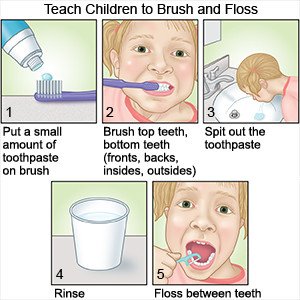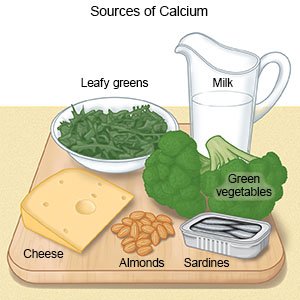Promote Healthy Teeth and Gums in Young Children
Medically reviewed by Drugs.com. Last updated on Aug 4, 2025.
What do I need to know about healthy teeth and gums in young children?
You can help your child develop good habits early that will continue as an adult. Healthy teeth and gums start even before your child gets his or her first tooth. Your child needs good nutrition and mouth care starting from birth. By age 3, your child will have about 20 teeth. Baby teeth help make space for adult teeth. They also help your child speak clearly and eat solid food. Decay in baby teeth can cause problems in the adult teeth that replace them. This is called early childhood caries. Your child's dentist can give you more information about decay in your child's teeth before 6 years.
How can I teach my child to care for his or her teeth and gums?
- Be a good role model. Children often learn just by watching their parents. Let your child see you take care of your teeth and gums. You may need to bend down or get onto your knees so your child can see better. Brush and floss every day, and go to the dentist regularly. Talk to your child about each step of how you care for your teeth. Be consistent with your own tooth care. This will help your child be consistent with his or hers.
- Make tooth care fun. Let your child choose his or her own toothbrush and toothpaste. Your child may be more willing to brush if he or she likes the design of the toothbrush and the flavor of the toothpaste. Make sure the toothbrush is the right size for your child's mouth and age. Check the toothpaste to make sure it has fluoride. You and your child may want to create a chart. Your child can put a sticker on each time he or she brushes and flosses.
- Help your child create a tooth care routine. Set 2 times each day for tooth care. The time of day does not have to be exact. For example, the times may be after breakfast and before bed. Be as consistent as possible, even on weekends, holidays, and vacations. This will help your child make tooth care part of a lifetime routine. Make sure your child has enough time to brush for at least 2 minutes each time. Your child might want to play a song that lasts at least 2 minutes while brushing.
How do I brush my child's teeth?
 |
- From birth to 1 year, use a clean washcloth to wipe your baby's gums. You can start brushing your baby's teeth as soon as they start to appear. Use a baby toothbrush with a soft head. Put a small amount (the size of a grain of rice) of fluoride toothpaste on the toothbrush. Go over the teeth with a washcloth to remove any remaining toothpaste. Brush 1 time each day.
- From 1 to 3 years, your child needs to have his or her teeth brushed 2 times each day. Brush your child's teeth with a children's toothbrush and water. Your child's healthcare provider may recommend that you brush his or her teeth with a small smear of toothpaste that contains fluoride. Make sure your child spits all of the toothpaste out. He or she does not need to rinse with water. The small amount of toothpaste that stays in your child's mouth can help prevent cavities.
- From 3 to 6 years, your child needs to have his or her teeth brushed with fluoride toothpaste 2 times each day. You should also floss your child's teeth 1 time each day. Brush for at least 2 minutes. Apply a pea-sized amount of toothpaste on the toothbrush. Make sure your child spits all of the toothpaste out. He or she does not need to rinse with water. The small amount of toothpaste that stays in your child's mouth can help prevent cavities.
What do I need to know about fluoride?
Fluoride is a mineral that helps prevent cavities. Fluoride is found in some foods and in drinking water in certain areas. It is also available in toothpastes, and fluoride applications at the dentist's office.
- Children need fluoride starting at the age of 6 months. Ask your healthcare provider how much fluoride your child needs. Children under the age of 6 years can develop fluorosis if they get too much fluoride. Fluorosis is a condition that changes the way your child's teeth look. Fluorosis can occur when your child's teeth are forming under his or her gums.
- Children between 6 months and 2 years can get fluoride from drinking water. Ask your dentist if your drinking water contains enough fluoride. If it does not contain enough fluoride, your child may need a supplement.
- Children over the age of 2 years can get fluoride from drinking water and toothpaste.
What else can I do to help keep my child's teeth and gums healthy?
- Take your child to the dentist as directed. Your child should start seeing a dentist at 1 year of age. Your healthcare provider may instead recommend that your child see a dentist within 6 months after the first tooth comes in. After 1 year of age, your child should go to the dentist for a checkup and cleaning every 6 months.
- Do not put your baby to bed or nap time with a bottle. Breast milk and formula contain sugars. If your baby falls asleep with a bottle, these liquids can sit in his or her mouth and cause cavities. Instead, hold your baby while you feed him or her and then put your baby down to sleep.
- Limit fruit juice as directed. Fruit juice is high in sugar. Offer fruit juice with meals, or not at all. Do not give your baby fruit juice in a bottle. Do not give your child fruit juice in a cup he or she can carry around during the day. Limit fruit juice to 4 ounces a day from 6 months to 1 year. Limit to 4 to 6 ounces a day from 1 year to 6 years.
- Provide healthy foods and drinks to your child. Healthy foods include vegetables, lean meats, fish, cooked beans, and whole-grain cereals. Choose foods and drinks that are low in sugar. Read food labels to help you choose foods that are low in sugar. Limit candy, cookies, and soda. Do not dip your child's pacifier in sugar, syrup, or any other sweetened liquid.
- Talk to your child's healthcare provider about calcium. Calcium will help make your child's teeth strong. Your child's provider can tell you how much calcium your child needs each day. He or she can also give you a list of foods that contain calcium. Dairy foods such as yogurt and cheese are examples.

- Ask about thumb sucking. Thumb sucking can affect the way your child's teeth line up. Talk to your child's dentist or healthcare provider if your child sucks his or her thumb after age 2 years. The provider can tell you if your child's teeth are being affected by thumb sucking. He or she may also give you ideas on how to help your child stop.
- Ask about bottles and pacifiers. Bottles and pacifiers can affect your child's teeth as they come in. By 1 year, your baby should no longer need to use a bottle. He or she should be drinking from a cup. Your baby should also stop using pacifiers by 1 year. Talk to your baby's healthcare provider about ways to help wean your baby from bottles and pacifiers.
Care Agreement
You have the right to help plan your child's care. Learn about your child's health condition and how it may be treated. Discuss treatment options with your child's healthcare providers to decide what care you want for your child. The above information is an educational aid only. It is not intended as medical advice for individual conditions or treatments. Talk to your doctor, nurse or pharmacist before following any medical regimen to see if it is safe and effective for you.© Copyright Merative 2025 Information is for End User's use only and may not be sold, redistributed or otherwise used for commercial purposes.
Learn more about Promote Healthy Teeth and Gums in Young Children
Care guides
Further information
Always consult your healthcare provider to ensure the information displayed on this page applies to your personal circumstances.
